|
Protection from Harm
by Bob Brooke
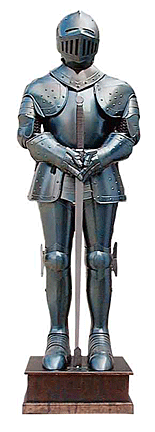 Soldiers going into
battle have worn some sort of protective armor since the late Bronze
Age. This took the form of plate armor—personal body armor made from
bronze, iron, or steel plates—culminating in the iconic suit of
armor entirely encasing the wearer. Full plate steel armor developed
in Europe during the late Middle Ages from the coat of plates worn
over mail suits during the 14th century. Soldiers going into
battle have worn some sort of protective armor since the late Bronze
Age. This took the form of plate armor—personal body armor made from
bronze, iron, or steel plates—culminating in the iconic suit of
armor entirely encasing the wearer. Full plate steel armor developed
in Europe during the late Middle Ages from the coat of plates worn
over mail suits during the 14th century.
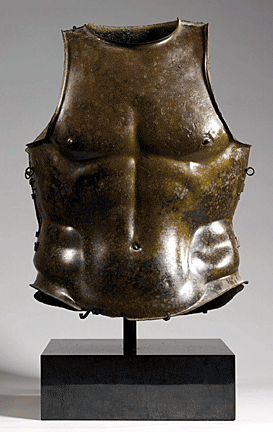 Ancient Greek warriors wore partial plate armor, made out of bronze,
which protected their chest and the lower limbs. During Classic
antiquity, warriors wore less restrictive heavy armor in the form of
the muscle cuirass. Parthian and Sassanian heavy cavalry known as
Clibanarii used cuirasses made of scales or mail and small,
overlapping plates in the manner of the manica for the protection of
arms and legs. Roman soldiers used plate armor in the form of the
Lorica segmentata between the 1st century BCE and 4th century CE. Ancient Greek warriors wore partial plate armor, made out of bronze,
which protected their chest and the lower limbs. During Classic
antiquity, warriors wore less restrictive heavy armor in the form of
the muscle cuirass. Parthian and Sassanian heavy cavalry known as
Clibanarii used cuirasses made of scales or mail and small,
overlapping plates in the manner of the manica for the protection of
arms and legs. Roman soldiers used plate armor in the form of the
Lorica segmentata between the 1st century BCE and 4th century CE.
Medieval Armor
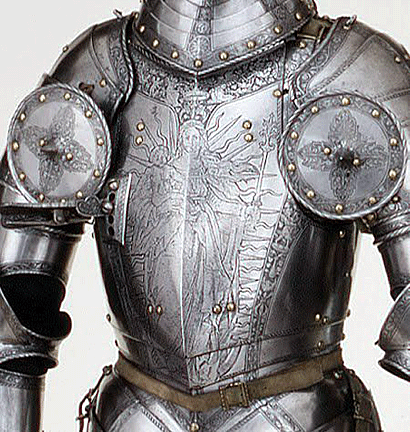 Soldiers again used single plates of metal armor, which they wore
over a mail hauberk, from the late 13th century on, to protect
joints and shins.. Over time, the number of plate components of
medieval armor increased, protecting further parts of the body, and
in protecting those of a cavalryman's horse. Armorers developed
skills in articulating the individual plates for parts of the body
that needed to be flexible, and in fitting armor to the individual
wearer like a tailor. The cost of a full suit of high quality fitted
armor, as opposed to less expensive munition armor was very high, so
only wealthy aristocrats seriously committed to either soldiering or
jousting could afford it. The rest of an army wore inconsistent
mixtures of pieces, with mail playing an important role. Soldiers again used single plates of metal armor, which they wore
over a mail hauberk, from the late 13th century on, to protect
joints and shins.. Over time, the number of plate components of
medieval armor increased, protecting further parts of the body, and
in protecting those of a cavalryman's horse. Armorers developed
skills in articulating the individual plates for parts of the body
that needed to be flexible, and in fitting armor to the individual
wearer like a tailor. The cost of a full suit of high quality fitted
armor, as opposed to less expensive munition armor was very high, so
only wealthy aristocrats seriously committed to either soldiering or
jousting could afford it. The rest of an army wore inconsistent
mixtures of pieces, with mail playing an important role.
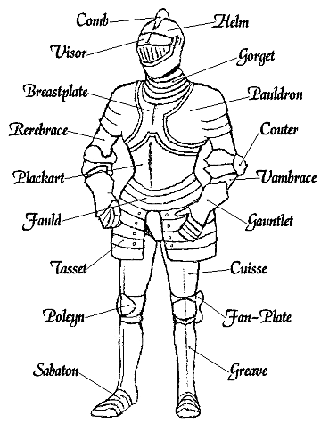 By about 1420, complete suits of plate armor had been developed in
Europe. A full suit of plate armor would have consisted of a helmet,
a gorget, spaulders, pauldrons with gardbraces to cover the armpits
as was seen in French armor, or besagews or rondels, mostly used in
Gothic armor, covered the armpit area and couters and poleyns with
"wings" protected the inside of the joint. rerebraces, vambraces,
gauntlets, a cuirass, or breastplate and backplate, with a fauld,
tassets and a culet, a mail skirt, cuisses, poleyns, greaves, and
sabatons. By about 1420, complete suits of plate armor had been developed in
Europe. A full suit of plate armor would have consisted of a helmet,
a gorget, spaulders, pauldrons with gardbraces to cover the armpits
as was seen in French armor, or besagews or rondels, mostly used in
Gothic armor, covered the armpit area and couters and poleyns with
"wings" protected the inside of the joint. rerebraces, vambraces,
gauntlets, a cuirass, or breastplate and backplate, with a fauld,
tassets and a culet, a mail skirt, cuisses, poleyns, greaves, and
sabatons.
The very fullest sets, known as garnitures, more often made for
jousting than war, included pieces of exchange, alternate pieces
suiting different purposes, so that the suit could be configured for
a range of different uses, for example fighting on foot or on horse.
By the Late Middle Ages even infantry could afford to wear several
pieces of plate armor.
A complete suit of plate armor made from well-tempered steel weighed
around 33 to 55 pounds. The wearer could jump, run and otherwise
move freely, with the armor’s weight spread evenly over the body. To
accomplish this, armorers articulated the armor so that it covered a
soldier’s entire body.
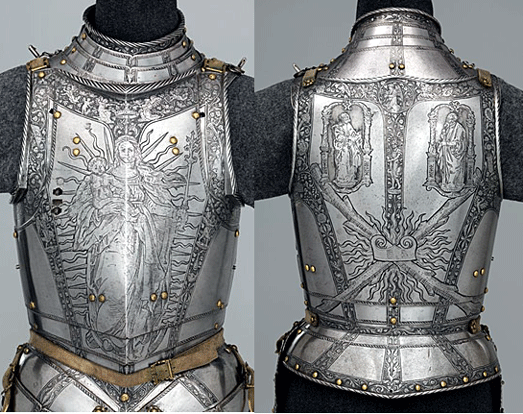
The movement of armorers helped to diffuse armor styles around
Europe. A royal workshop near London that had imported Italian,
Flemish and German craftsmen, produced Renaissance Greenwich armor,
though it soon developed its own unique style.
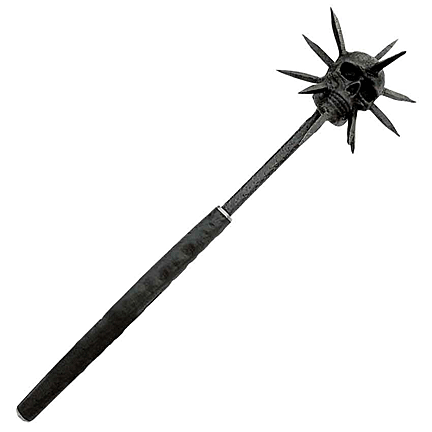 Virtually invulnerable to sword slashes, plate armor also protected
the wearer against spear or pike thrusts and provided a good defense
against blunt trauma. While this armor was effective against cuts or
blows, long tapered swords, pollaxes and halberds could penetrate
its weak spots. Virtually invulnerable to sword slashes, plate armor also protected
the wearer against spear or pike thrusts and provided a good defense
against blunt trauma. While this armor was effective against cuts or
blows, long tapered swords, pollaxes and halberds could penetrate
its weak spots.
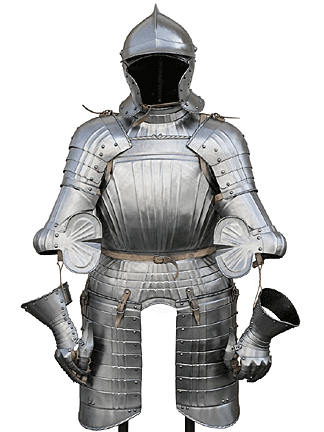 Warriors used maces, war hammers, and the hammer-heads of pollaxes
to inflict blunt trauma through the enemy’s armor. Strong blows to
the head could result in concussion even if the armor hadn’t been
penetrated. Warriors used maces, war hammers, and the hammer-heads of pollaxes
to inflict blunt trauma through the enemy’s armor. Strong blows to
the head could result in concussion even if the armor hadn’t been
penetrated.
Fluted plate was not only decorative, but also reinforced the plate
against bending under slashing or blunt impact. This offsets against
the tendency for flutes to catch piercing blows. In armored
techniques taught in the German school of swordsmanship, the
attacker concentrates on these "weak spots", resulting in a fighting
style very different from unarmored sword-fighting. Renaissance Armor
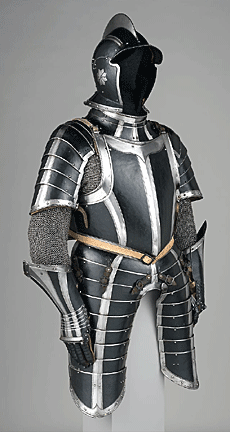 German so-called Maximilian armor of the early 16th century was a
style that employed heavy fluting and some decorative etching, as
opposed to the plainer finish on 15th-century white armor. During
the same period, armorers reformed the helmet and neckguard design
to produce the so-called Nürnberg armor, many masterpieces of
workmanship and design. German so-called Maximilian armor of the early 16th century was a
style that employed heavy fluting and some decorative etching, as
opposed to the plainer finish on 15th-century white armor. During
the same period, armorers reformed the helmet and neckguard design
to produce the so-called Nürnberg armor, many masterpieces of
workmanship and design.
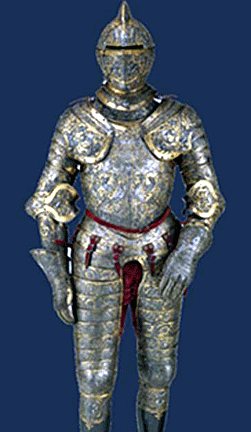 As firearms became better and more common on the battlefield, the
utility of full armor gradually declined. Full suits of armor became
restricted to those made for jousting. The decoration of fine armor
greatly increased during this time, as armorers began using a range
of techniques. This greatly increased the cost. They also produced
elaborately decorated plate armor for royalty and the very wealthy. As firearms became better and more common on the battlefield, the
utility of full armor gradually declined. Full suits of armor became
restricted to those made for jousting. The decoration of fine armor
greatly increased during this time, as armorers began using a range
of techniques. This greatly increased the cost. They also produced
elaborately decorated plate armor for royalty and the very wealthy.
Highly decorated armor has often been referred to as parade armor, a
somewhat misleading term as such armor might have also been worn on
active military campaigns. King Henry II of France, had his armor,
made in 1555, covered with meticulous embossing, which had been
subjected to blueing, silvering and gilding.
Such work required armorers to either collaborate with artists or
have artistic skill of their own. Other artists such as Hans Holbein
the Younger also produced designs for armor. The Milanese armorer
Filippo Negroli was the most famous modeler of figurative relief
decoration on armor during the Renaissance.
Jousting Armor
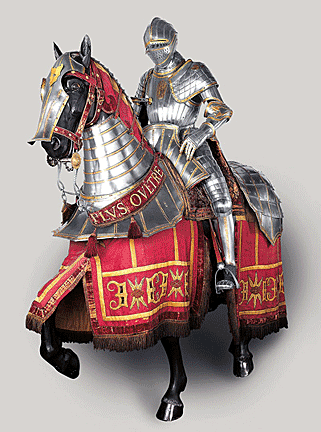 Unlike actual warfare, jousting was a favorite sport of 15th and
16th-century nobles throughout Europe. The medieval joust has its
origins in the military tactics of heavy cavalry during the High
Middle Ages. And because it had less to do with direct warfare,
participating knights could use specialized armor and equipment. Unlike actual warfare, jousting was a favorite sport of 15th and
16th-century nobles throughout Europe. The medieval joust has its
origins in the military tactics of heavy cavalry during the High
Middle Ages. And because it had less to do with direct warfare,
participating knights could use specialized armor and equipment.
Specialized jousting armor was heavier and could weigh as much as 50
kg; Since it was never intended to be used in combat, it didn’t need
to permit free movement. However, it was limited to the maximum
weight that could be carried by a warhorse of the time.
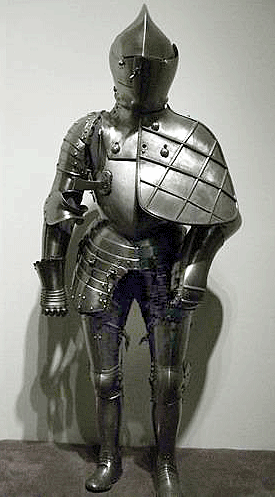 Compared to the standard joust, the Rennen was a type of joust with
lighter contact. Here, the aim was to hit the opponent's shield.
Maxmillian, who wanted a return to a more agile form of joust
compared to the heavily armored "full contact" Stechen joust,
developed the specialized Rennzeug, In the Rennzeug, the shield was
attached to the armor with a mechanism of springs and would detach
itself upon contact. Compared to the standard joust, the Rennen was a type of joust with
lighter contact. Here, the aim was to hit the opponent's shield.
Maxmillian, who wanted a return to a more agile form of joust
compared to the heavily armored "full contact" Stechen joust,
developed the specialized Rennzeug, In the Rennzeug, the shield was
attached to the armor with a mechanism of springs and would detach
itself upon contact.
The development of powerful firearms made all but the finest and
heaviest armor obsolete. Leg protection was the first part to go,
replaced by tall leather boots. By the beginning of the 18th
century, only field marshals, commanders and royalty remained in
full armor on the battlefield. It remained fashionable for monarchs
to be portrayed in armor up to and including the first half of the
18th century.
<
Back
to More Back in Time
Next Article > |
